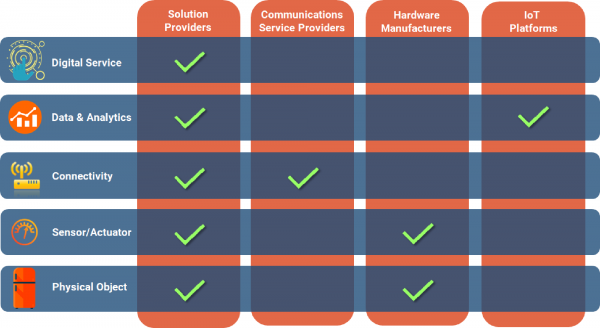
The business landscape of IoT
February 18, 2019
With billions of physical objects already connected to the Internet, the Internet of Things (IoT) has become a reality that’s being looked at and deployed by a variety of industries to further unlock operational efficiencies and develop new applications. A study published by McKinsey in 2015 estimates the economic value of IoT to reach USD11.1 trillion a year by 2025.
While the potential of IoT has been demonstrated in many fields, including utilities, healthcare, smart cities and farming, the adoption of IoT solutions still lags the forecasts made by IoT enthusiasts at the start of the hype. For many businesses, the IoT landscape still appears to be too fragmented, with the overwhelming number of technologies, standards and platforms contributing to this perception. Other barriers to adoption are lack of knowledge of IoT, in addition to security, interoperability and cost concerns.
IoT can be considered as an extension of the Internet to real world physical objects with the aim to collect and analyse data to provide actionable insight. Unlike the Internet, the IoT brings with it a multitude of different situations that are more varied and complex than simply connecting a laptop or a smartphone. The complexity arises from the numerous types of end-devices, the different communications requirements, and the plethora of tools required to implement an IoT solution across many functional layers (Exhibit 1).
Exhibit 1: IoT functional layers and the role of service providers [Source: Network Strategies]

The borders between these layers are rather blurred. Analytics, for example, can occur at the edge (collocated with sensors), in the cloud, as part of the digital service or in all of these layers. As none of the typical IT service providers or hardware manufacturers are operational at all layers, IoT solutions require increased levels of planning, cooperation and partnership arrangements. In fact, according to a survey conducted by Cisco in 2017, a wide leveraging of partnerships across the IoT ecosystem was named as one of the most critical factors behind the success of IoT initiatives, whereas 74% of IoT initiatives failed due to human factors. These include lack of IoT expertise, corporate culture and budget overruns which reflect the fact that the IoT ecosystem is still largely unfamiliar to IT service providers.
In terms of technology, IoT does not seem to lack maturity. It has seen significant developments across all levels. IoT applications are supported by a wide range of personal, local and wide area networking technologies, including ZigBee, Bluetooth and Wi-Fi as well as non-standardised low power wide area networks (LPWAN) such as Sigfox and LoRa. Standardised 3GPP-based IoT technologies using the NB-IoT and LTE-M standards are also gaining momentum.
According to the Global mobile Suppliers Association (GSA), as at August 2018 at least 78 mobile operators in 35 countries have already launched NB-IoT and LTE-M within their LTE networks. Since LTE cellular networks are now ubiquitous and the marginal cost for upgrading the base stations to cater for IoT is very low, the deployment of these standards is likely to lower the connectivity costs of IoT solutions and increase uptake. There is also an increasing number of hardware vendors providing connectivity modules for end devices, with at least 150 module releases supporting LTE connectivity, according to GSA. Many IT companies, including major players such as Amazon, Microsoft, IBM, Google, Oracle and even appliances manufacturers such as Bosch are already providing cloud-based IoT platforms for data storage and analysis.
As much as the IoT landscape appears complex, it also offers additional flexibility for creating revenue streams. Most existing business models of IoT projects are still trapped in old patterns that fall into the broad classes of either improving current processes to achieve savings or providing products with more features. However, the convergence of the digital and physical domains enables a wider range of business models, including:
- cross-selling
- co-selling
- pay-per -use
- asset sharing, and
- benefit sharing models.
In cross-selling, the IoT connected product can provide a means to cross-sell services or products. Sensor as a Service is an example of cross-selling that can enable telecommunications infrastructure owners to generate revenue by selling sensor data.
In a similar manner to Facebook or LinkedIn, IoT connected products can be used as a vehicle to monetise data and co-sell products. For example, a supplier of smart shelves for supermarkets and warehouses, can sell the collected data to wholesalers who can use it for targeted marketing purposes, or alternatively the suppliers could use the shelves as a proxy to sell its own products.
Pay-per-use and asset sharing models are already used for many products such as IT equipment and heavy machinery. However, IoT would extend their use to many more products and improve the efficiency of existing applications. With the emergence of autonomous vehicles, these models are expected to transform how transport works and, according to some futurists, may make private car ownership obsolete.
In a benefit sharing scenario, the consumer pays a proportion of savings or revenues to the IoT solution provider. This model is ideally suited to efficiency improvement solutions, such in energy management.
If there is a main feature of the IoT landscape now, it would be the misalignment between the speed of technology development and business. To unlock the full potential of IoT, a wider partnership with all internal and external stakeholders is essential to compensate for expertise gaps, cost solutions efficiently and tackle interoperability issues. A top priority of any IoT solution should be having a clear and well-planned monetisation strategy. However, this often needs to occur in a much more complex ecosystem where a company has to position and accept itself as a part of a larger group with less control over the customers and the entire value proposition.
